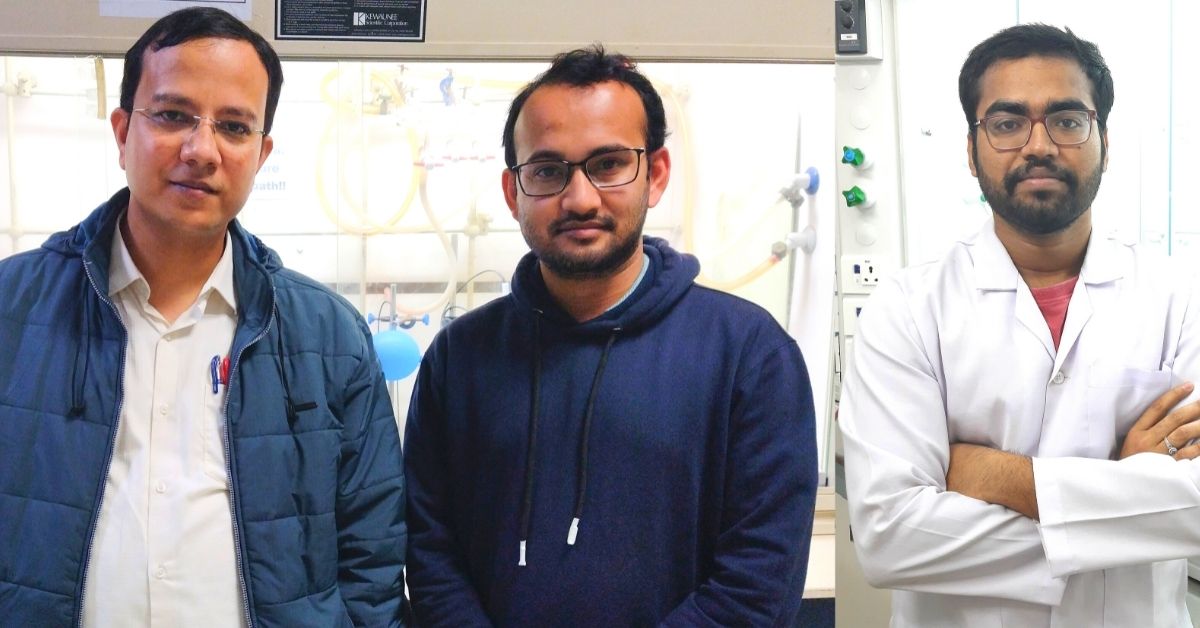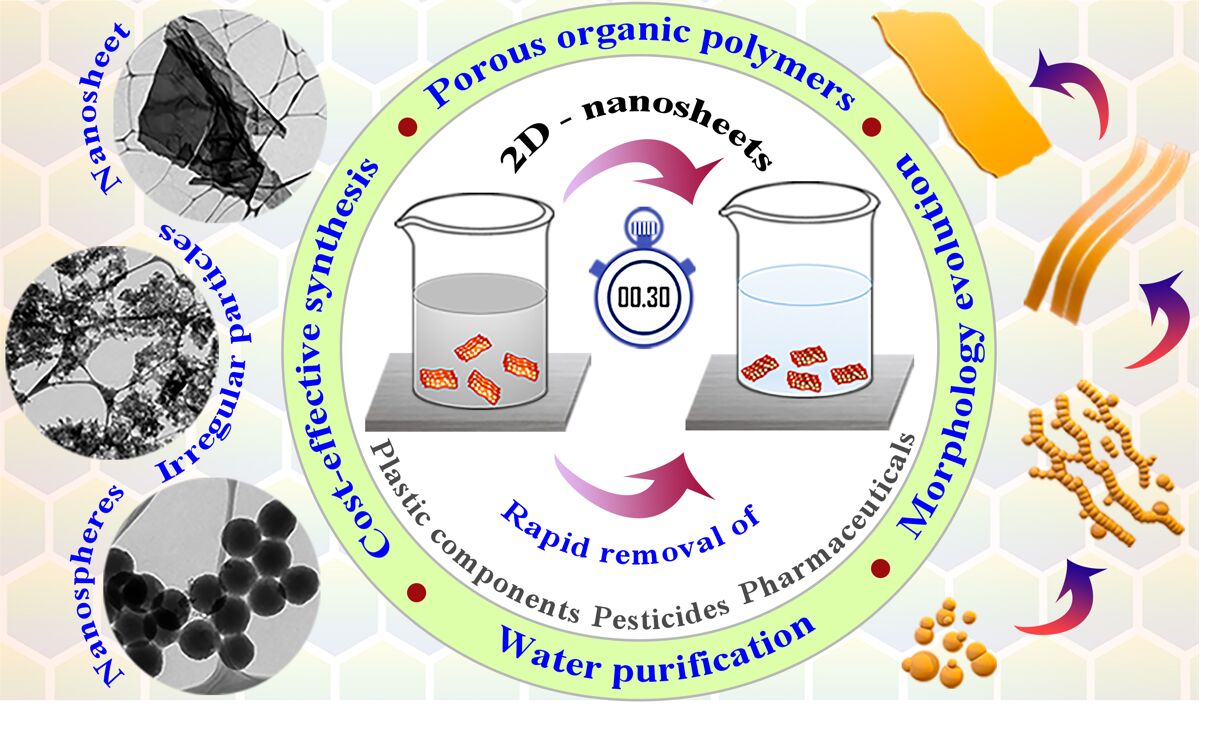Bhopal Scientists Develop Powder That Removes Pesticides From Water in 30 Seconds
Indian Institute of Science Education and Research (IISERB) Bhopal researchers have developed organic polymers that can remove highly polar organic micropollutants (POMs) from water. This process will render the water safer for human consumption.

In a significant development, researchers at the Indian Institute of Science Education and Research (IISERB), Bhopal, have developed organic polymers, which they claim can remove toxic micropollutants from water, thus making it safer for human consumption. (Image above L-R Dr. Abhijit Patra, Arkaprabha Giri, Subha Biswas)
The research team led by Dr Abhijit Patra, Associate Professor at the Department of Chemistry, IISER Bhopal, has tested these polymers in powder form for the removal of polar organic micropollutants removal at a laboratory scale. He believes large-scale fabrication of these materials in collaboration with industrial partners will open up avenues for real-time scavenging of toxic polar organic micropollutants from water.
Called hypercrosslinked porous organic polymers’ (HPOPs), researchers claim that a teaspoon of the powder of these polymers will cover a significantly large area. Speaking to The Better India, Dr Abhijit Patra, Associate Professor at the Department of Chemistry in IISER Bhopal, who led the research at the Functional Materials Laboratory of the Institute, says, “Per gram of the developed HPOPs has an internal surface area of 1000-2400 square meters. These HPOPs have numerous tiny pores in the nanometer (1 nm = 10-9 m) domain. If we hypothetically spread these materials and arrange these nanopores on a flat field, it can cover the area of 10 tennis courts,” he says.
Dr Patra notes that one teaspoon of these organic polymers can remove a range of water-soluble micropollutants, including plastic precursors, pesticides, herbicides, endocrine disruptors, antibiotics, steroid-based drugs, and ionic dyes from water. “Based on experimental data, we can say that 1 teaspoon of HPOPs can remove micropollutants (present in environmentally relevant concentration) from 2 litres of water in 30 seconds only. These HPOPs are recyclable and there was no decay in removal efficiency even after 10 cycles,” he says.
Going further, he explains the motivation behind embarking on this project.
“The water crisis in India has become severe in the last few decades. The tremendous need for portable water motivated us to work on this surging problem. For this, we extensively surveyed the scientific literature to design adsorbent materials for the efficient removal of various toxic micropollutants from water. To address the bottlenecks related to a slower rate of micropollutant separation, tedious regeneration processes, etc. we have developed scalable HPOPs by employing a simple synthetic protocol. The work was initiated in 2019. It took almost three years to complete the detailed study and publish it in the peer-reviewed journal of the American Chemical Society, ACS Applied Materials and Interfaces,” he explains.
The research team comprised: Arkaprabha Giri (PhD student, Department of Chemistry, IISER Bhopal), Subha Biswas (former BS-MS student of Department of Chemistry, IISERB, currently pursuing PhD at IISc Bangalore), Dr MD Waseem Hussain (former PhD student of Department of Chemistry, IISERB, currently pursuing post-doctoral research at Hanyang University, South Korea), Tapas Kumar Dutta (PhD student, Department of Chemistry, IISER Bhopal), and Dr Abhijit Patra (Associate Professor, Department of Chemistry, IISER Bhopal).
This project was funded by the Department of Science and Technology (DST), Government of India, under ‘Centre for Sustainable Treatment, Reuse and Management for Efficient, Affordable and Synergistic solutions for Water’ (WATER-IC for SUTRAM of EASY WATER) Initiative.
What Micropollutants Do HPOPs Remove?
The major organic micropollutants found in the surface water bodies are:
- Various pharmaceuticals such as antibiotics, and steroids, among others
- Industrial chemicals such as dyes, food additives, endocrine disruptors and plastic precursors, among others
- Agricultural disposals such as pesticides, herbicides, and fertilizers, among others.
Elaborating further on these micropollutants, lead author Arkaprabha Giri, a PhD student at the Department of Chemistry, IISER Bhopal, said in an earlier media interaction, “In India, the prime concern is water contamination due to anthropogenic waste discharged to surface and groundwater by domestic, agricultural, and industrial sectors. These wastes contain large numbers of organic/inorganic micropollutants. Organic micropollutants are a diverse set of ‘analytes’ whose presence in water, even in trace amounts, pose a serious threat to human health and aquatic lives.”
And Dr Patra goes on to add, “A process called ‘Sorption’ is one of the most energy-efficient techniques to purify water from organic micropollutants. However, commonly-used carbonaceous adsorbents possess several bottlenecks such as slow uptake rate and tedious regeneration process. Therefore, we need efficient adsorbent materials that can not only scavenge highly polar organic micropollutants (POMs) from water rapidly but also can be synthesized easily on a large-scale through simple fabrication techniques. This was the problem the IISER Bhopal Researchers at Functional Materials Laboratory set out to tackle.”
What you have as a result are these HPOPs that come with two distinct morphologies — spherical nanoparticles to the two-dimensional nanosheets. Both morphologies of HPOPs come in powdered form. “However, we found that the performance of 2D nanosheet-like HPOP is higher compared to the other towards decontaminating water. We recommend 2D nanosheet-like HPOP for future large-scale applications,” says Dr Patra.
He goes on to add, “HPOPs with 2D sheet-like morphology have a remarkably high surface area of 2,400 m2/g. This solvent knitted HPOP contains numerous numbers of tiny pores (a few nanometers; 1 lakh times smaller than the cross-section of a human hair). The 2D sheet-like HPOP can act as a sponge for the adsorption of various organic micropollutants from water.”
In other words, 2D nanosheet-like HPOP can remove 85%-99% of the broad-spectrum organic micropollutants, including antibiotics, endocrine disruptors, steroid-based drugs, ionic dyes, plastic precursors, pesticides, and herbicides in 30 seconds only. The water can be drinkable after a few additional treatments to remove contaminants other than micropollutants.

Industrial Use
The main advantage of these HPOPs includes large-scale fabrication using cheap and simple aromatic precursors without requiring any transition metal-based exotic catalysts. “We used simple organic building blocks and linked them by the solvent molecules (dichloromethane) using a cheap catalyst, anhydrous aluminium chloride (Rs 1/ g). This solvent knitting process led to the HPOP with 2D sheet-like morphology having a high surface area of 2,400 m2/g,” says Dr Patra. He also says that these HPOPs have high thermal and hydrothermal stability.
As of now, the developed materials have been tested for laboratory-scale study. The developed materials show great promise for large-scale applications. “We are further collaborating and expanding the study with IIT Madras researchers for real-time use of these adsorbent materials for organic micropollutant separation. Water treatment and water technology-based companies may benefit immensely from this research,” he adds.
(Edited by Yoshita Rao)
Like this story? Or have something to share? Write to us: [email protected], or connect with us on Facebook and Twitter.
If you found our stories insightful, informative, or even just enjoyable, we invite you to consider making a voluntary payment to support the work we do at The Better India. Your contribution helps us continue producing quality content that educates, inspires, and drives positive change.
Choose one of the payment options below for your contribution-
By paying for the stories you value, you directly contribute to sustaining our efforts focused on making a difference in the world. Together, let’s ensure that impactful stories continue to be told and shared, enriching lives and communities alike.
Thank you for your support. Here are some frequently asked questions you might find helpful to know why you are contributing?


This story made me
-
97
-
121
-
89
-
167













